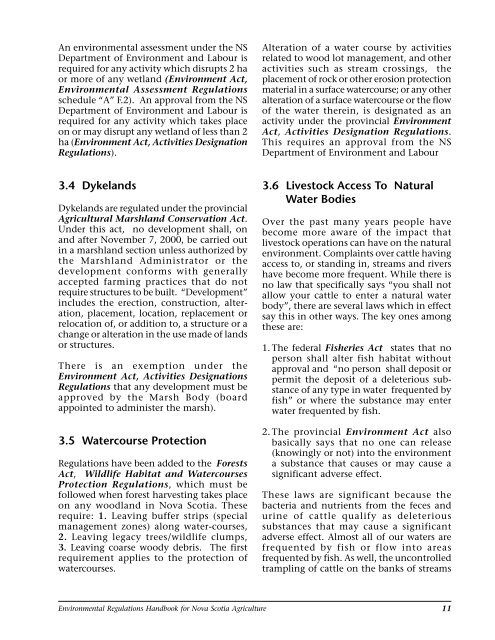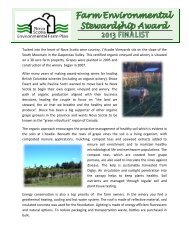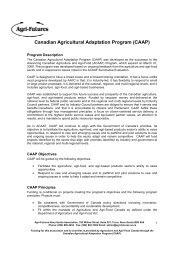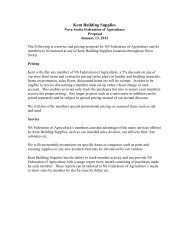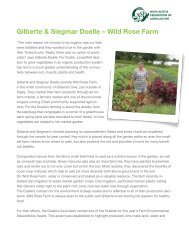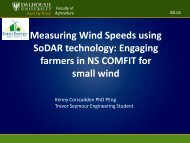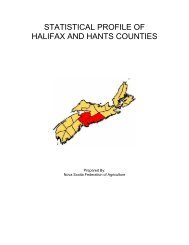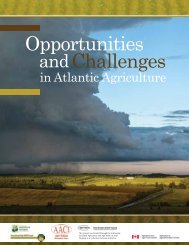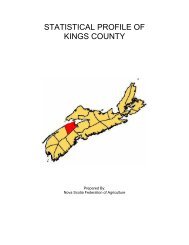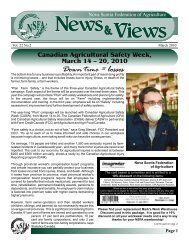Environmental Regulations Handbook for Nova Scotia Agriculture
Environmental Regulations Handbook for Nova Scotia Agriculture
Environmental Regulations Handbook for Nova Scotia Agriculture
Create successful ePaper yourself
Turn your PDF publications into a flip-book with our unique Google optimized e-Paper software.
An environmental assessment under the NS<br />
Department of Environment and Labour is<br />
required <strong>for</strong> any activity which disrupts 2 ha<br />
or more of any wetland (Environment Act,<br />
<strong>Environmental</strong> Assessment <strong>Regulations</strong><br />
schedule “A” F.2). An approval from the NS<br />
Department of Environment and Labour is<br />
required <strong>for</strong> any activity which takes place<br />
on or may disrupt any wetland of less than 2<br />
ha (Environment Act, Activities Designation<br />
<strong>Regulations</strong>).<br />
Alteration of a water course by activities<br />
related to wood lot management, and other<br />
activities such as stream crossings, the<br />
placement of rock or other erosion protection<br />
material in a surface watercourse; or any other<br />
alteration of a surface watercourse or the flow<br />
of the water therein, is designated as an<br />
activity under the provincial Environment<br />
Act, Activities Designation <strong>Regulations</strong>.<br />
This requires an approval from the NS<br />
Department of Environment and Labour<br />
3.4 Dykelands<br />
Dykelands are regulated under the provincial<br />
Agricultural Marshland Conservation Act.<br />
Under this act, no development shall, on<br />
and after November 7, 2000, be carried out<br />
in a marshland section unless authorized by<br />
the Marshland Administrator or the<br />
development con<strong>for</strong>ms with generally<br />
accepted farming practices that do not<br />
require structures to be built. “Development”<br />
includes the erection, construction, alteration,<br />
placement, location, replacement or<br />
relocation of, or addition to, a structure or a<br />
change or alteration in the use made of lands<br />
or structures.<br />
There is an exemption under the<br />
Environment Act, Activities Designations<br />
<strong>Regulations</strong> that any development must be<br />
approved by the Marsh Body (board<br />
appointed to administer the marsh).<br />
3.5 Watercourse Protection<br />
<strong>Regulations</strong> have been added to the Forests<br />
Act, Wildlife Habitat and Watercourses<br />
Protection <strong>Regulations</strong>, which must be<br />
followed when <strong>for</strong>est harvesting takes place<br />
on any woodland in <strong>Nova</strong> <strong>Scotia</strong>. These<br />
require: 1. Leaving buffer strips (special<br />
management zones) along water-courses,<br />
2. Leaving legacy trees/wildlife clumps,<br />
3. Leaving coarse woody debris. The first<br />
requirement applies to the protection of<br />
watercourses.<br />
3.6 Livestock Access To Natural<br />
Water Bodies<br />
Over the past many years people have<br />
become more aware of the impact that<br />
livestock operations can have on the natural<br />
environment. Complaints over cattle having<br />
access to, or standing in, streams and rivers<br />
have become more frequent. While there is<br />
no law that specifically says “you shall not<br />
allow your cattle to enter a natural water<br />
body”, there are several laws which in effect<br />
say this in other ways. The key ones among<br />
these are:<br />
1. The federal Fisheries Act states that no<br />
person shall alter fish habitat without<br />
approval and “no person shall deposit or<br />
permit the deposit of a deleterious substance<br />
of any type in water frequented by<br />
fish” or where the substance may enter<br />
water frequented by fish.<br />
2. The provincial Environment Act also<br />
basically says that no one can release<br />
(knowingly or not) into the environment<br />
a substance that causes or may cause a<br />
significant adverse effect.<br />
These laws are significant because the<br />
bacteria and nutrients from the feces and<br />
urine of cattle qualify as deleterious<br />
substances that may cause a significant<br />
adverse effect. Almost all of our waters are<br />
frequented by fish or flow into areas<br />
frequented by fish. As well, the uncontrolled<br />
trampling of cattle on the banks of streams<br />
<strong>Environmental</strong> <strong>Regulations</strong> <strong>Handbook</strong> <strong>for</strong> <strong>Nova</strong> <strong>Scotia</strong> <strong>Agriculture</strong><br />
11


